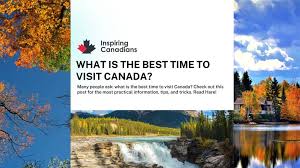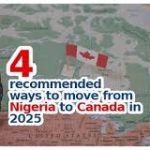The Best Time to Travel to Canada
Canada, the second-largest country in the world, is a land of breathtaking natural beauty, diverse cultures, and vibrant cities. From the rugged Rocky Mountains in the west to the charming French influence in Quebec, Canada offers travelers endless opportunities to explore.
However, choosing the right time to visit is essential for making the most of your trip. The country’s massive size means that climates and travel experiences vary drastically depending on the season and region.
In this comprehensive guide, we will explore the best time to travel to Canada, considering weather conditions, outdoor activities, cultural events, budget considerations, and regional differences.
By the end, you’ll have a clearer idea of when to pack your bags and embark on an unforgettable journey.
Understanding Canada’s Climate and Seasons
Canada’s weather is heavily influenced by geography. The country stretches across six time zones, and climates vary from arctic in the north to temperate near the southern border. Despite these variations, the seasons generally fall into four main categories:
-
Winter (December – February): Cold temperatures, snow, and ideal conditions for skiing, snowboarding, and winter festivals.
-
Spring (March – May): Gradual thawing, blooming landscapes, and fewer crowds.
-
Summer (June – August): Warm weather, long daylight hours, and peak tourist season.
-
Autumn (September – November): Crisp air, colorful foliage, and quieter tourist spots.
Knowing what each season brings will help you align your travel goals with the best possible timing.
Traveling to Canada in Winter (December to February)
Weather
Canadian winters are legendary. In most parts of the country, temperatures can range from -5°C to -30°C (23°F to -22°F). Cities like Montreal, Ottawa, and Toronto experience heavy snow, while Vancouver on the west coast has milder, rainy winters.
Best Experiences in Winter
-
Skiing and Snowboarding: Resorts like Whistler Blackcomb in British Columbia and Banff in Alberta are world-class destinations for winter sports.
-
Winter Festivals: Quebec City’s Winter Carnival, held in February, is one of the largest in the world, featuring ice sculptures, parades, and traditional activities.
-
Northern Lights: In northern regions like Yukon, Nunavut, and the Northwest Territories, winter offers the best chance to see the aurora borealis.
-
Ice Skating: Ottawa’s Rideau Canal becomes the world’s largest natural skating rink.
Who Should Visit in Winter?
Winter is perfect for adventure seekers and cultural enthusiasts who want to experience the magic of Canadian traditions. However, it may not be ideal for travelers uncomfortable with freezing temperatures.
Traveling to Canada in Spring (March to May)
Weather
Spring in Canada varies greatly. In March, snow is still common, especially in the north and mountainous regions. By April and May, temperatures warm up, ranging between 5°C and 20°C (41°F to 68°F).
Best Experiences in Spring
-
Cherry Blossoms in Vancouver: In April, Vancouver bursts into pink with cherry blossom season.
-
Tulip Festival in Ottawa: The Canadian Tulip Festival in May celebrates the city’s historical ties with the Netherlands and attracts thousands of visitors.
-
Wildlife Watching: Spring is a good time for whale watching in British Columbia and birdwatching across the country.
-
National Parks: Fewer crowds make parks like Jasper and Gros Morne more enjoyable.
Advantages of Visiting in Spring
-
Lower accommodation costs compared to summer.
-
Smaller crowds at major attractions.
-
A balance between winter activities and early summer experiences.
Traveling to Canada in Summer (June to August)
Weather
Summer is Canada’s most popular travel season. Temperatures range from 20°C to 30°C (68°F to 86°F) in southern regions, while northern areas enjoy mild, pleasant weather. Days are long, especially in the north where the sun hardly sets in some areas.
Best Experiences in Summer
-
Exploring National Parks: Banff, Jasper, and Yoho offer crystal-clear lakes, hiking trails, and camping.
-
Cultural Events: Toronto hosts the Caribana Festival, Montreal features the International Jazz Festival, and Calgary is famous for the Calgary Stampede.
-
Outdoor Adventures: Canoeing in Algonquin Park, hiking the Cabot Trail in Nova Scotia, or cycling in Prince Edward Island.
-
Whale Watching: The St. Lawrence River and Bay of Fundy are prime spots.
-
Canadian Rockies Road Trip: Summer is the best time to drive along the Icefields Parkway between Banff and Jasper.
Drawbacks of Summer Travel
-
High tourist demand means expensive flights and accommodations.
-
Popular attractions can be crowded.
Traveling to Canada in Autumn (September to November)
Weather
Autumn is one of the most picturesque times to visit Canada. Temperatures range between 5°C and 20°C (41°F to 68°F). The season is famous for its colorful foliage, especially in Ontario, Quebec, and the Atlantic provinces.
Best Experiences in Autumn
-
Fall Foliage: Algonquin Park, the Laurentians, and Cape Breton Highlands are breathtaking in late September and October.
-
Wine Tours: British Columbia’s Okanagan Valley and Ontario’s Niagara Peninsula host harvest festivals and wine tastings.
-
Cultural Events: Thanksgiving celebrations in October and Halloween festivities across the country.
-
Hiking: Trails are less crowded, and cooler weather makes hiking more comfortable.
Advantages of Visiting in Autumn
-
Beautiful landscapes at their peak.
-
Lower costs compared to summer.
-
Mild weather perfect for both outdoor and urban exploration.
Regional Differences to Consider
Western Canada (British Columbia & Alberta)
-
Best in summer for outdoor adventures and mountain exploration.
-
Winter is ideal for skiing in Whistler or Banff.
Central Canada (Ontario & Quebec)
-
Summer is vibrant with festivals in Toronto, Montreal, and Quebec City.
-
Autumn offers stunning foliage, especially around Niagara Falls and the Laurentians.
Atlantic Canada (Nova Scotia, New Brunswick, Prince Edward Island, Newfoundland & Labrador)
-
Best in summer and early autumn for coastal drives, seafood festivals, and whale watching.
Northern Canada (Yukon, Northwest Territories, Nunavut)
-
Winter and autumn are perfect for seeing the northern lights.
-
Summer offers the midnight sun and remote wilderness adventures.
Budget Considerations
-
Peak Season (Summer): Highest prices for hotels and flights. Book early to save.
-
Shoulder Seasons (Spring & Autumn): Moderate prices with fewer crowds—best balance between cost and experience.
-
Off-Season (Winter): Lower costs, but limited accessibility in some areas. Winter resorts may still be expensive.
Festivals and Events to Time Your Visit
-
January – February: Quebec Winter Carnival, Winterlude in Ottawa.
-
March – April: Maple Syrup Festivals in Ontario and Quebec.
-
June – July: Canada Day celebrations, Montreal Jazz Festival, Calgary Stampede.
-
August: Toronto’s Caribana Festival.
-
September – October: Fall harvest festivals, Thanksgiving celebrations.
-
December: Christmas markets and New Year’s Eve events across major cities.
Final Thoughts: When is the Best Time to Travel to Canada?
The best time to travel to Canada depends on your interests:
-
For winter sports and northern lights, visit in December to February.
-
For blooming landscapes and lower costs, spring (March to May) is ideal.
-
For festivals, hiking, and warm weather, summer (June to August) is unbeatable.
-
For stunning foliage and peaceful exploration, autumn (September to November) is perfect.
Ultimately, Canada is a year-round destination. Each season offers a unique flavor, whether it’s the adrenaline of skiing down snow-covered slopes, the joy of watching cherry blossoms bloom, the thrill of summer festivals, or the serenity of autumn colors.
By aligning your travel goals with the right season, you can create a Canadian adventure that is both memorable and tailored to your personal preferences.










